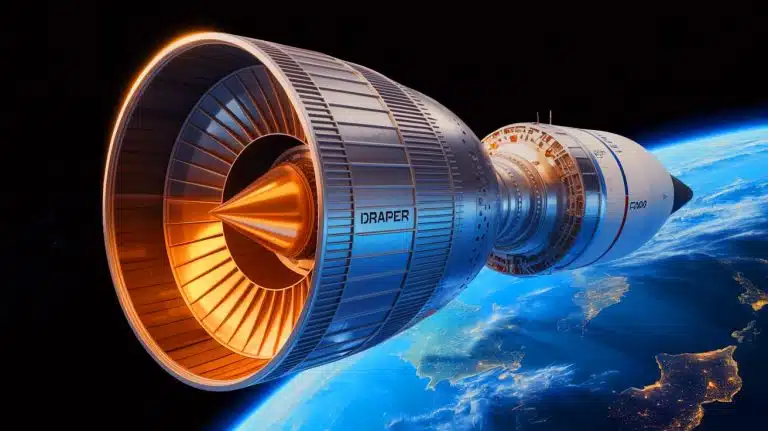| IN A NUTSHELL |
|
The ever-evolving landscape of space and defense technology continues to witness groundbreaking advancements. One such development is the Draper engine by Ursa Major, a Colorado-based company. This innovative propulsion system is designed to meet the challenges of modern space-based defense and hypersonic applications. The Draper engine combines the storability of a solid motor with the high performance and maneuverability of a liquid engine, making it a strategic asset for national security. As the U.S. navigates through an era of increasing adversarial activity in space, the introduction of such advanced technology could prove pivotal in maintaining a tactical edge.
Revolutionizing Space-Based Defense
Ursa Major’s Draper engine is poised to play a crucial role in space-based defense. Designed for rapid response and in-space maneuverability, it offers unique advantages over traditional propulsion systems. The engine’s ability to restart, control throttle, and precisely maneuver makes it suitable for a variety of mission profiles. According to Dan Jablonsky, CEO of Ursa Major, the Draper engine provides the responsiveness needed to counter emerging threats in space and missile defense. The engine’s design reflects a shift in defense propulsion, ensuring readiness across multiple domains, including land, sea, air, and space.
Importantly, the Draper engine operates on non-cryogenic, non-toxic propellants, enhancing its safety and usability. With a $34.9 million contract from an undisclosed U.S. aerospace and defense firm, Ursa Major is set to accelerate the development and deployment of the Draper engine. This contract underscores the strategic importance of advanced propulsion systems in securing national defense capabilities in space.
Engineered for Hypersonic Defense
The Draper engine's design is tailored for hypersonic applications, addressing a critical gap in America's defense capabilities. Unlike solid rocket motors traditionally used in missile defense systems, the Draper engine offers active throttle control and a wide throttle range. This flexibility is essential for responding to the unpredictable nature of hypersonic threats. As adversaries develop more complex hypersonic weapons, the need for responsive and adaptive propulsion systems becomes evident.
Successfully hot-fired more than 250 times, Draper is safe, reusable, and designed to be storable for at least 10 years.
https://www.sustainability-times.com/energy/asian-maglev-trains-race-ahead-while-us-and-europe-stagnate-weve-missed-20-years-of-progress/
Ursa Major's approach to the Draper engine emphasizes affordability and efficiency. With nearly two-thirds of its components additively manufactured and 100% American-made, the engine is produced cost-effectively. The recent $28.6 million contract with the U.S. Air Force Research Laboratory further solidifies Draper's role in demonstrating hypersonic capabilities. As a lead integrator for a tactical flight demonstrator, Ursa Major showcases Draper's potential to revolutionize hypersonic defense.
Advanced Manufacturing and Cost Efficiency
The Draper engine's production process stands out for its use of additive manufacturing, which reduces costs and complexity. By leveraging this technology, Ursa Major accelerates development timelines, ensuring that the engine meets the urgent needs of national defense. The engine's closed catalyst cycle and non-cryogenic propellants contribute to its practical storable nature, making it a reliable option for long-term applications.
Ursa Major's commitment to using American-made components underscores its dedication to supporting domestic industry and innovation. The engine's low part count simplifies production, allowing for rapid scaling and deployment. As global defense dynamics evolve, the ability to produce efficient and adaptable propulsion systems becomes increasingly vital. The Draper engine exemplifies how advanced manufacturing can enhance defense capabilities while maintaining cost-effectiveness.
Implications for Future Defense Strategies
The introduction of the Draper engine highlights the importance of innovation in maintaining strategic defense advantages. As space becomes a more contested domain, the U.S. must continue to invest in technologies that offer flexibility and responsiveness. The Draper's ability to simulate hypersonic threats positions it as a valuable tool for testing and developing missile defense systems.
“Draper represents a paradigm shift in defense propulsion on land, at sea, in the air, and now, in space.”
With adversaries advancing their capabilities, the U.S. faces the challenge of adapting its defense strategies to counter new threats effectively. The Draper engine serves as a testament to the potential of innovative propulsion systems to enhance national security. As the U.S. continues to explore ways to strengthen its defense posture, how will emerging technologies like the Draper engine shape future military and space strategies?
Did you like it? 4.4/5 (20)








Wow, $34.9 million is a lot of money! Is this engine really worth it? 🤔
Wow, $34.9 million is a lot! Is this engine really worth the money?
🚀 Go Ursa Major! Can’t wait to see what the Draper engine can do in space! 🌌
Another step towards Star Wars? Count me in! 🚀